How to Eat a Durian? 8 Easy Steps!
To eat a durian, first, lay down newspapers or plastic sheets to catch any mess. With gloves on, locate the seams on the durian’s husk and use a sharp knife to make an initial cut.
Pry the husk open to reveal the creamy yellow flesh. Remove the large seeds and enjoy the fruit fresh, being mindful of its unique, pungent aroma.
Durian, known as the “King of Fruits,” is famous for its strong odor and distinctive taste.
The spiky outer husk can make it intimidating to open, but following these steps simplifies the process:
Eating durian is a unique experience due to its complex flavor profile, which some adore and others find challenging.
Despite its notorious scent, durian is cherished for its rich custardy texture and sweet, almond-like taste, often enjoyed in Southeast Asian cuisines.

Key Takeaway
Understanding Durian Varieties
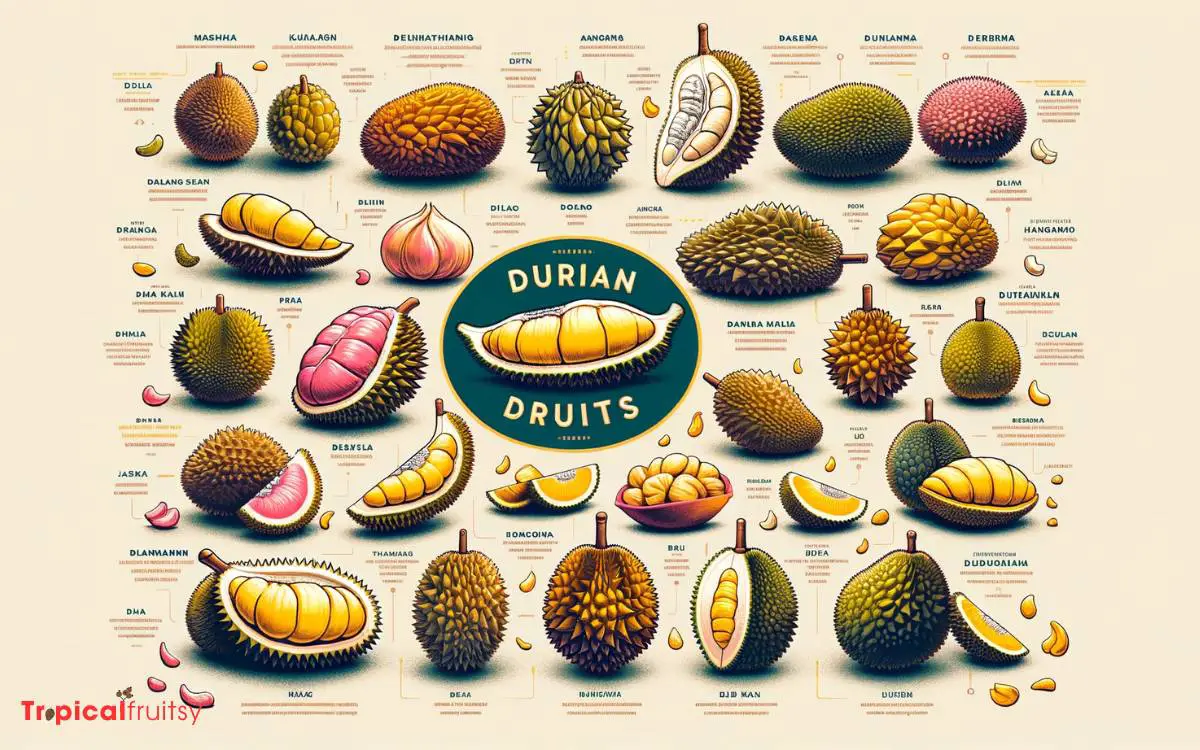
Before indulging in the King of Fruits, it’s essential to recognize the durian’s diverse varieties, each with its unique flavor profile and texture.
Revered for its complexity, the durian ranges from the coveted Musang King, which boasts a rich, creamy texture and a deep, tantalizing bittersweet taste, to the D24, offering a more mellow sweetness with a slight bitterness that lingers on the palate.
Each variety presents a symphony of flavors waiting to be savored, from the honey-kissed sweetness of Red Prawn to the pale, delicate flesh of the elusive Black Thorn.
Step 1: Selecting the Perfect Fruit
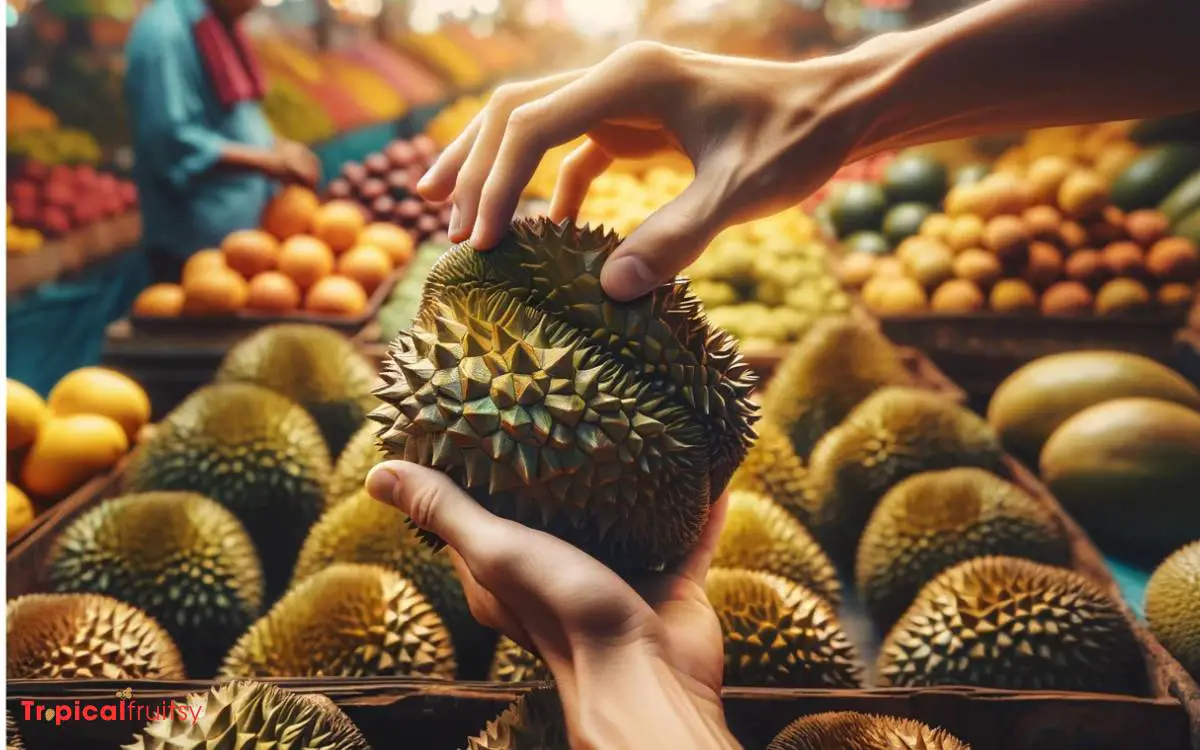
The quest for the perfect durian begins with mastering the art of discerning ripeness through subtle cues; a skill that differentiates the novice from the connoisseur.
A gentle press against the husk should yield slightly under the fingertips—too hard indicates immaturity, while excessive softness may signal overripeness.
This tactile examination, known as the Shell Firmness Test, is a critical step in guaranteeing a durian’s creamy texture and complex flavor profile that enthusiasts revere.
Assessing Ripeness Cues
Selecting a ripe durian is essential for an optimal taste experience, and several indicators can help determine the fruit’s readiness for consumption.
A connoisseur knows that the perfect durian should feel like a cherished secret, unveiled through its unique ripeness cues.
These cues are not just signs, but a symphony of sensory signals that guide the enthusiast to the moment of delectable indulgence.
| Ripeness Cue | Description |
|---|---|
| Aroma | Intense, distinctive; a ripe durian releases a strong, pungent smell that is unmistakable. |
| Stem | Appears dry and can easily be wiggled; signifies the fruit has matured adequately. |
| Sound | Upon shaking, a subtle, dull sound indicates the seeds are loose – a sign of ripeness. |
| Feel | Yields slightly under gentle pressure; the husk should not be rock-hard nor overly mushy. |
Embrace these cues to unveil a durian’s hidden splendors, ensuring your journey to its creamy, complex interior is nothing short of perfection.
Shell Firmness Test
Evaluating the shell’s firmness is a crucial step in selecting the ideal durian, as it reveals much about the fruit’s internal texture and maturity.
A durian connoisseur will gently press the husk with their fingers, sensing for a slight give that indicates the flesh within is creamy and ripe, yet not overripe.
Too hard, and the durian is under-ripe, promising a less succulent experience. Too soft, it may be past its prime, with a fermented taste that overshadows the fruit’s naturally rich, complex flavors.
This tactile examination is an art form, honed by experience and a deep appreciation for the king of fruits. With the perfect durian selected, it’s time to prepare your workspace for the ceremonial unveiling.
Step 2: Preparing Your Workspace
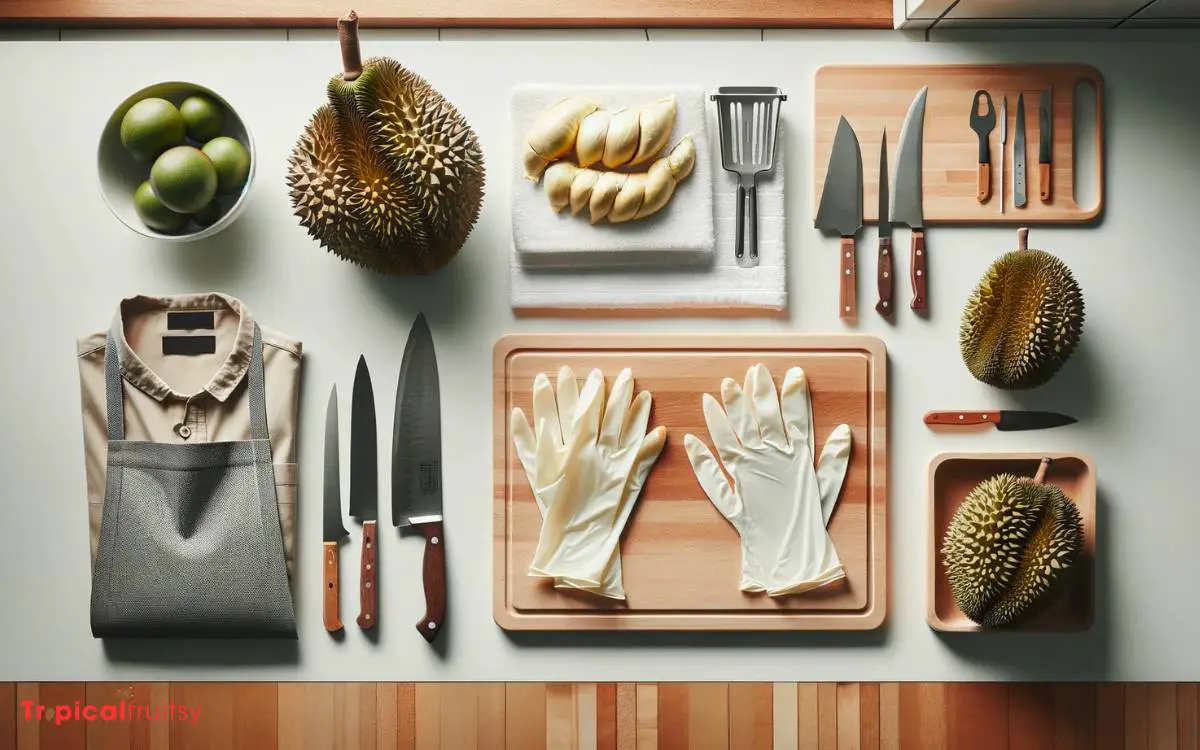
Before venturing into the rich and pungent world of durian consumption, it is imperative to meticulously prepare your workspace to enhance the experience and manage the fruit’s potent aroma.
Ensuring your surface is shielded with durable coverings will protect against the durian’s spiky husk and potentially lingering scents.
Equipping oneself with the proper tools—notably a sharp knife and gloves—combined with effective odor management strategies, such as ventilation and odor neutralizers, is essential for a seamless durian indulgence.
Surface Protection
Cover your workspace with a large sheet of disposable plastic or a durable cutting board to safeguard surfaces from the durian’s strong odor and spiky husk.
The pungent aroma of durian is notorious for permeating through materials, leaving a lingering scent that some may find unpleasant.
By using a protective layer, you not only prevent the odor from seeping into your countertops but also protect them from the potential scratches and punctures that the fruit’s formidable exterior could cause.
This act of precaution is a testament to the respect that durian commands as a culinary experience.
Moreover, it facilitates a smoother cleanup process, allowing you to maintain a pristine kitchen environment.
With your workspace now secure, the next crucial step is selecting the right tools to handle the durian effectively.
Tool Selection
Selecting the appropriate knife is imperative when preparing to cut open a durian, as the fruit’s thick husk requires a sharp, sturdy blade for efficient penetration.
The ideal tool is a large, heavy-duty kitchen knife with the following characteristics:
Blade Quality
- Material: High-carbon stainless steel is preferred for its durability and rust resistance.
- Length: A blade of 8 to 10 inches allows for better leverage and control.
- Sharpness: A well-honed edge is essential to slice through the husk without excessive force.
Handle Ergonomics
- Grip: The handle should be comfortable to hold with a non-slip surface.
- Balance: A well-balanced knife reduces hand fatigue during the cutting process.
Maintenance
- Cleaning: Wash by hand to preserve the blade’s edge; dishwashers can be detrimental.
- Sharpening: Regular honing maintains the blade’s sharpness; professional sharpening is recommended annually.
With the right knife at hand, you can approach this culinary challenge with confidence and finesse.
Odor Management
While the distinct aroma of durian is cherished by many, it can be overpowering, hence preparing your workspace with adequate ventilation is crucial to managing the fruit’s pervasive scent.
The king of fruits demands respect not only in taste but also in the way its odor is handled. This is not just about comfort—it is about immersing in the durian experience while being considerate of those around you.
To facilitate this, we’ve provided a concise table that outlines key steps to prepare your workspace.
| Step | Description |
|---|---|
| 1. Choose Location | Opt for an outdoor space or a well-ventilated room. |
| 2. Air Circulation | Set up fans or open windows to keep air moving. |
| 3. Protective Coverings | Use disposable tablecloths to catch remnants. |
| 4. Neutralizers | Have coffee grounds or baking soda at hand. |
| 5. Waste Management | Prepare a sealable container for immediate disposal. |
Embrace these measures to ensure a harmonious durian degustation.
Step 3: Safe Durian Handling Techniques

Handling durian fruit safely necessitates understanding its unique anatomy, including the sharp exterior spikes that require careful maneuvering to avoid injury.
Here are meticulous techniques to ensure a safe and enjoyable durian experience:
Preparation
- Gloves: Wear thick gloves to protect hands from the spikes.
- Surface: Place durian on a stable, flat surface to prevent rolling.
- Tools: Use a sharp knife specifically designed for durian or a strong kitchen knife.
The skilled art of handling durian, much like admiring a piece of intricate sculpture, requires patience, precision, and a keen understanding of the fruit’s formidable armor. With these techniques, you are well on your way to mastering the durian’s challenge.
Step 4: Cutting the Durian Open
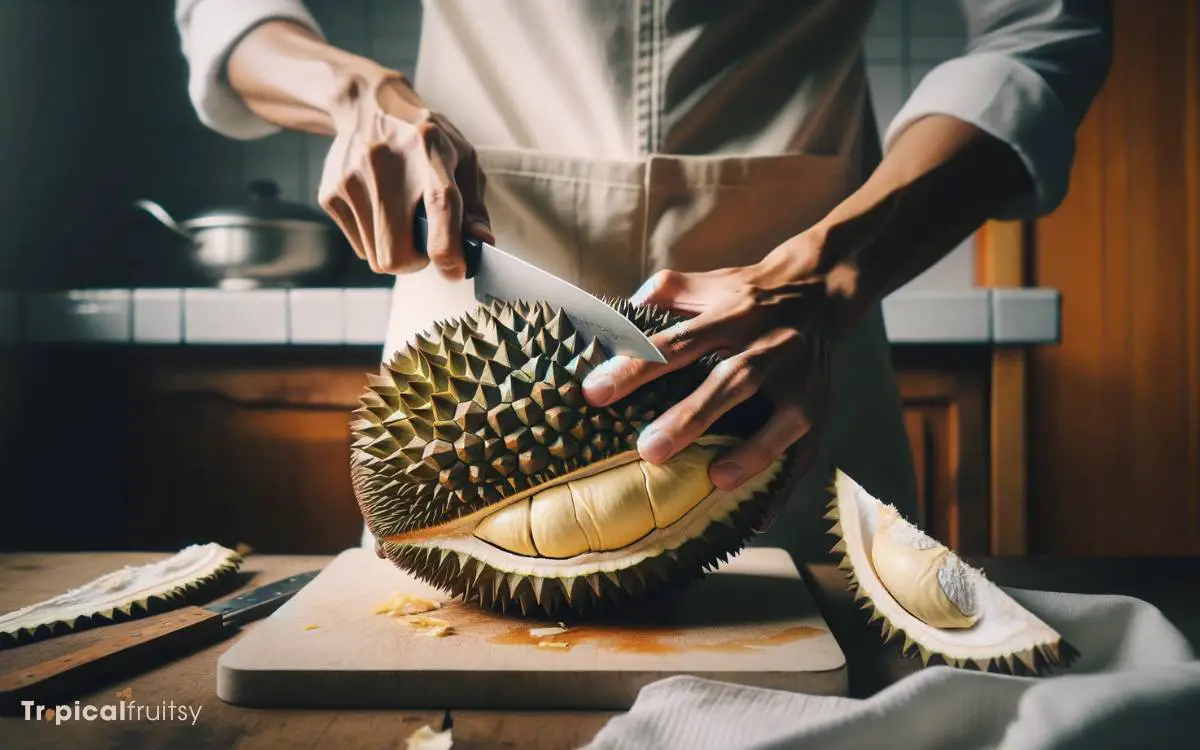
Upon equipping oneself with the appropriate protective gear and securing the durian, the next step is to make a careful incision along the fruit’s natural seams. This procedure is not merely a routine cut; it is an art that respects the fruit’s formidable armor.
The durian’s husk has distinctive ridges that guide the connoisseur in unveiling its hidden treasures.
With a sharp knife, one must gently press into these seams and pry the husk apart. It is a task that requires finesse, to avoid crushing the creamy flesh within.
As you coax the layers apart, a rich, pungent aroma—a siren’s call to durian aficionados—wafts into the air, heralding the sensory pleasures awaiting within the chambers of this exotic delicacy.
Step 5: Extracting the Flesh Properly
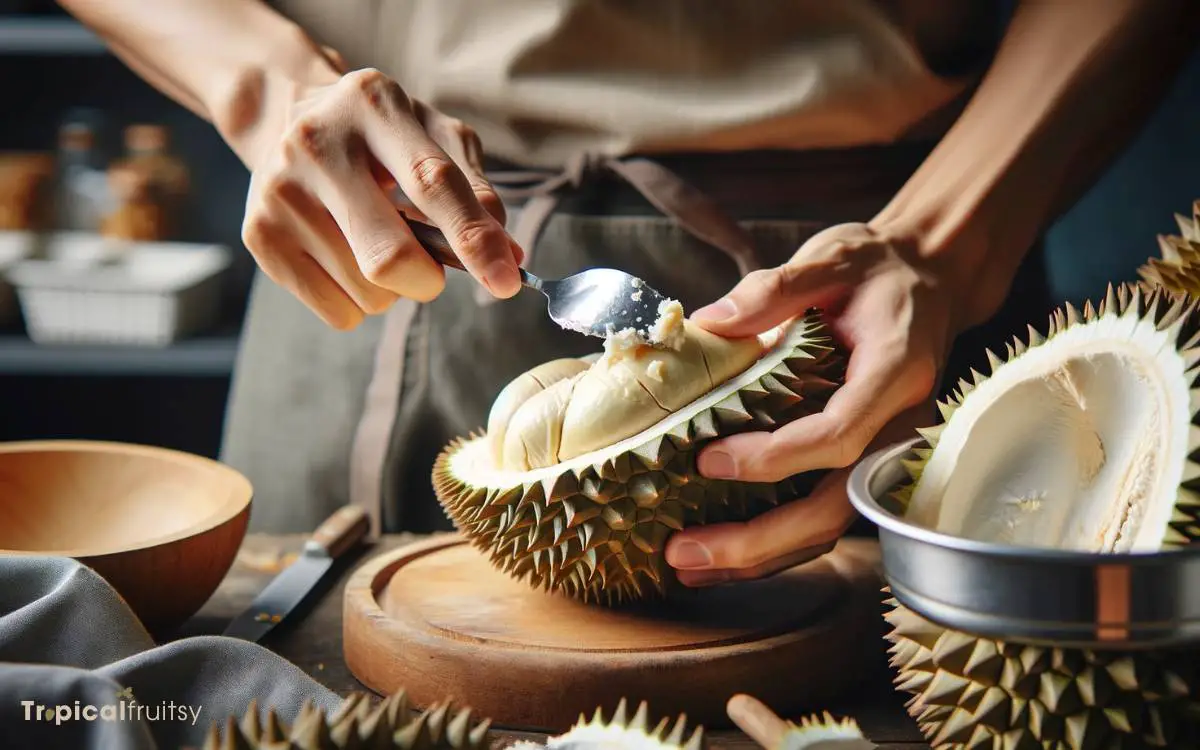
Having pried open the durian, carefully remove the large, edible lobes of flesh from each segment, ensuring minimal contact to preserve their shape and texture.
Approach with respect: – Use gloves or a small cloth to cradle the flesh. – Gently separate the lobes from the rind with the caress of a skilled artist.
Recognize the anatomy: – Identify the seams along which the segments naturally divide. – Use a paring knife if necessary, but do so with surgical precision.
Preserve the integrity: – Lift each piece intact, avoiding rupture of the creamy pulp. – Admire the golden custard-like segments, a testament to nature’s ingenuity.
In this endeavor, every motion should be deliberate and every touch, a testament to the sanctity of the king of fruits.
Step 6: Tasting Durian for the First Time

After carefully extracting the flesh, prepare yourself for the unique tasting experience of durian, marked by its potent aroma and complex flavor profile.
As you bring a piece of the creamy flesh to your lips, let go of any preconceived notions. Engage all your senses.
The initial impression is often dictated by the scent, which can be overwhelmingly strong, but beneath it lies a rich tapestry of flavors.
The taste, an intricate blend of sweet and savory, has been likened to a combination of almonds, cheddar cheese, and caramel, with a hint of onion. Its custard-like texture contrasts with the divisive olfactory experience.
Embrace the durian’s paradoxical nature; let the initial shock of the smell give way to the fruit’s unexpectedly indulgent and nuanced palate. This is the rite of passage for every durian novice – a sensory journey like no other.
Step 7: Pairing Durian With Other Foods

Beyond its standalone complexity, durian pairs well with a variety of other foods, enhancing and complementing different culinary elements.
Connoisseurs appreciate the depth it adds when thoughtfully combined with other ingredients:
Sweet endeavors:
- Sticky rice: The creaminess of durian blends seamlessly with the texture of sticky rice, often resulting in a beloved Southeast Asian dessert.
- Ice cream: Infused in ice cream, durian offers a rich custard-like flavor that is both indulgent and refreshing.
- Pancakes: A dollop of durian flesh can transform ordinary pancakes into a tropical breakfast treat.
These pairings highlight the fruit’s versatility, revealing layers of taste and texture that delight the palate.
Step 8: Storing Leftover Durian

To maintain the freshness of durian for future consumption, proper storage methods are essential. Any enthusiast of this ‘king of fruits’ understands that the creamy, custard-like texture and unique flavor profile are best preserved under certain conditions.
Leftover durian should be placed in an airtight container to minimize exposure to air, which can alter its aromatic intensity and hasten spoilage.
If you plan to indulge within a couple of days, refrigeration is suitable; the cold environment will slow down the fruit’s degradation.
For prolonged preservation, freezing is preferable. Seal the durian flesh in vacuum-packed bags to retain its delectable taste and prevent freezer burn.
Thaw with care, ideally in the refrigerator, to ensure the sublime experience of savoring durian is uncompromised when you return for your next culinary adventure.
How to Make Durian Taste Good
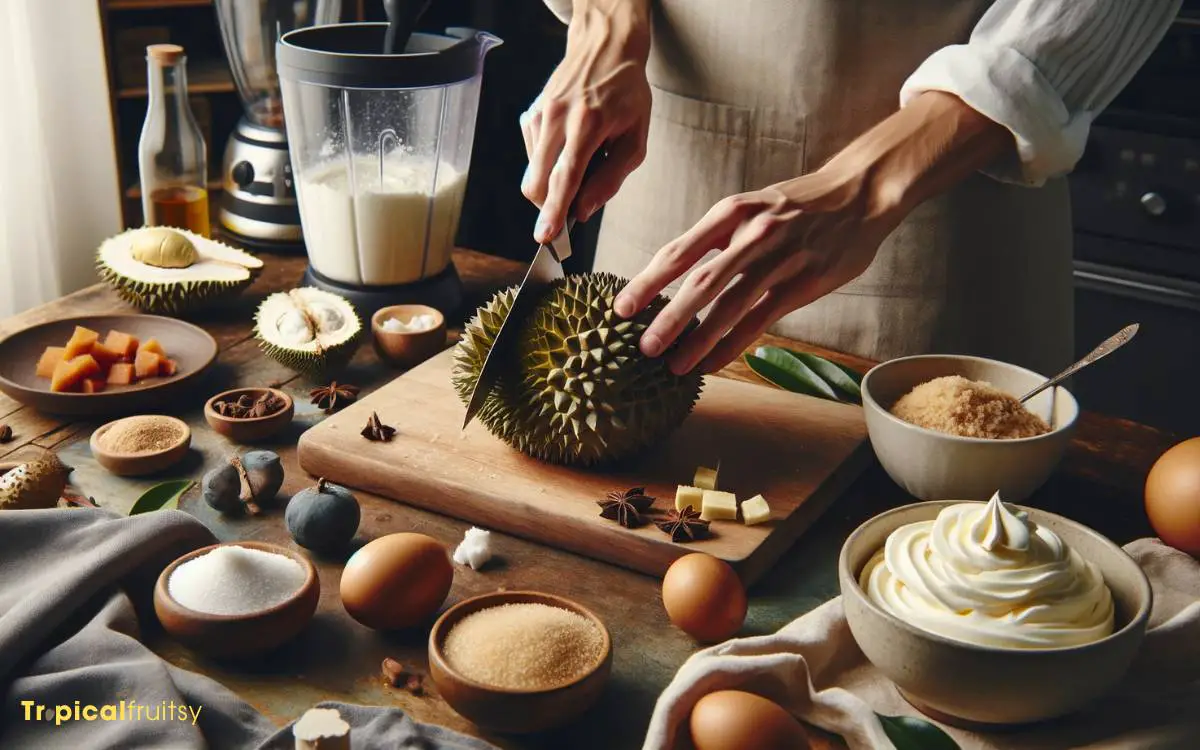
Durian is a unique tropical fruit with a strong and distinctive flavor that can be quite polarizing. Some people love it, while others find its taste and smell challenging to appreciate.
If you’re looking to make durian taste better or want to enhance your experience with this fruit, here are some tips and ideas:
- Choose the Right Variety: There are several varieties of durian, each with its own flavor profile. If you have access to different types, consider trying a milder or less pungent variety, which may be more palatable to your taste buds.
- Freshness Matters: Select ripe and fresh durian. The taste and texture of durian can vary significantly depending on its ripeness. A ripe durian should have a strong aroma and yield slightly to gentle pressure when touched.
- Pair with Complementary Flavors: Combine durian with foods and ingredients that complement its richness and sweetness. Some popular pairings include coconut milk, mango, sticky rice, or a drizzle of honey. These combinations can balance out durian’s intense flavor.
- Freeze It: Chilling or freezing durian can mellow its flavor and make it more enjoyable, especially if you find the fresh version too overpowering.
- Blend into Smoothies: Mix durian with other fruits and ingredients in a smoothie to dilute its flavor and create a more balanced taste. Try combinations with banana, yogurt, coconut water, and honey to create a creamy and flavorful beverage.
- Add to Desserts: Incorporate durian into desserts like ice cream, custard, or pancakes. When combined with sweet ingredients, durian can contribute a unique and delightful flavor to these treats.
- Balance with Citrus: Squeeze a bit of lemon or lime juice over durian to add a refreshing tartness that can counteract its richness.
- Use in Baking: Incorporate durian into baked goods like cakes, muffins, or tarts to create desserts with a subtle durian flavor. The sweetness of the baked goods can help mellow the fruit’s intensity.
- Combine with Chocolate: Pair durian with dark chocolate or cocoa-based desserts to balance its sweetness with the slight bitterness of chocolate.
- Experiment with Spices: Experiment with spices like cardamom, cinnamon, or nutmeg to complement the flavor of durian in dishes or desserts.
- Acclimate Your Palate: If you’re new to durian, it may take some time for your palate to adjust to its taste. Try small amounts initially and gradually increase the quantity as you become more accustomed to the flavor.
- Enjoy with an Open Mind: Approach durian with an open mind and a sense of adventure. The experience of eating durian is as much about the aroma and texture as it is about the taste.
- Respect Individual Preferences: Remember that not everyone will enjoy durian, and that’s perfectly okay. Taste is highly subjective, so it’s essential to respect individual preferences and differences.
Ultimately, the key to making durian taste good is finding a way to enjoy its unique flavor, whether through creative pairings, culinary experimentation, or simply acquiring a taste for it over time.
Keep in mind that durian is an acquired taste for many, so don’t be discouraged if you don’t immediately love it.
Conclusion
The durian, often revered as the ‘king of fruits,’ offers a culinary adventure for the daring palate.
Mastering the art of selection, preparation, and consumption of this formidable fruit rewards the connoisseur with a tapestry of flavors unparalleled in the fruit world.
Properly stored, the durian’s majesty can be preserved, allowing its unique essence to be savored in future indulgences and exquisitely paired delicacies, solidifying its regal status in the pantheon of gastronomy.






